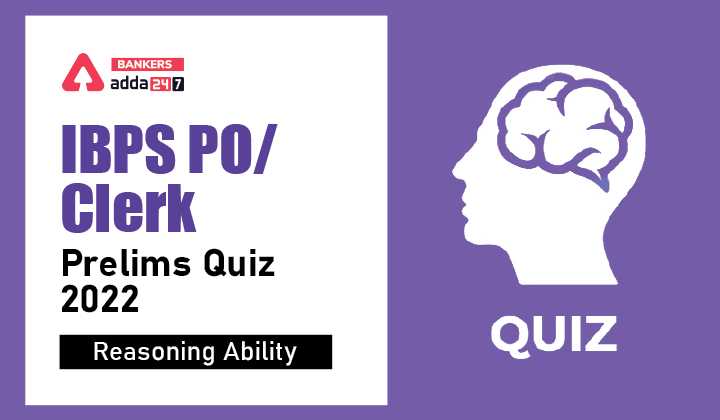Directions (1-5): Study the information carefully and answer the questions given below.
Seven persons A, B, C, D, E, F, and G are living in seven different floor building, in such a way ground floor is numbered as 1 and the top floor is numbered as 7. Each of the person studies in different std. i.e., VI, VII, VIII, IX, X, XI and XII. All information is not necessarily in same order.
Only two persons live between A and G, who lives on even number floor. One person lives between A and the one who is studying in VI. The one who studies in XI lives just above the one who studies in VIII. E lives on sixth floor and studies in XII. The one who studies in VIII lives above the one who studies in VII and below the one who studies in X. G neither study in VIII nor study in VII. One person lives between F and the one who studies in IX. B lives above D and below C. Neither A nor G study in XI. One person lives between A and B, who does not study in VI.
Q1. Who among the following person lives the top floor?
(a) E
(b) A
(c) F
(d) B
(e) None of these
Q2. Who among the following person studies in X?
(a) The one who lives on the fourth floor
(b) F
(c) B
(d) The one who lives on the fifth floor
(e) None of these
Q3. How many persons live between E and G?
(a) Two
(b) Four
(c) Three
(d) One
(e) None
Q4. Who among the following person studies in IX?
(a) The one who lives on the second floor
(b) A
(c) The one who lives on the third floor
(d) B
(e) None of these
Q5. Four of the following five are alike in a certain way based on a group, find the one that does not belong to that group?
(a) C
(b) The one who studies in VIII
(c) The one who studies in IX
(d) D
(e) A
Direction (6-10): In each of the questions below some statements are given followed by two conclusions. You have to take the given statements to be true even if they seem to be at variance with commonly known facts. Read all the conclusions and then decide which of the given conclusions logically follows from the given statements disregarding commonly known facts.
(a) If only conclusion I follows.
(b) If only conclusion II follows.
(c) If either conclusion I or II follows.
(d) If neither conclusion I nor II follows.
(e) If both conclusions I and II follow.
Q6. Statements: P>S≥T; T>Q<R; R=N
Conclusion
I: P>N
II: R≥S
Q7. Statements: A>B<C=D≥E≥ G<F
Conclusion
I: B>F
II: C≥G
Q8. Statements: J>K=L; L>N>M; M<A
Conclusion
I: J>M
II: A>J
Q9. Statements: B=Y≥X>V; V<K>Q; Q=C
Conclusion
I: B>V
II: C≤X
Q10. Statements: Z>V<N=M≥E≥B<C
Conclusion
I: B>V
II: Z≥E
Directions (11-15): Study the information carefully and answer the questions given below.
Seven boxes J, K, L, M, N, O and P are placed one above other. Each box contains different numbers of bottles i.e., 12, 15, 19, 23, 25, 32 and 36. All information is not necessarily in same order.
Equal no. of box placed above and below the box, which contains 12 bottles. One box is placed between L and the box which contains 12 bottles. More than two boxes are placed between L and the box which contains 15 bottles. Box J is placed just below box O, which contains no. of bottles that is perfect square. Two boxes are placed between J and the box which contains 32 bottles. The number of bottles N contains is 4 more than the numbers of bottles K contains. Box K is placed below box M but above box P. Box J is not contains 15 bottles. One box is placed between L and J. The box which contains 32 bottles is not placed just above or just below box L. Box M is not placed just above or just below box L. Box M contains 2 bottles less than box L.
Q11. Box P contained how many bottles?
(a) 25
(b) 36
(c) 23
(d) 32
(e) None of these
Q12. What is the difference between the number of bottles in box K and L?
(a) 10
(b) 3
(c) 6
(d) 7
(e) None of these
Q13. How many bottles box O contains?
(a) 25
(b) 36
(c) 32
(d) 23
(e) None of these
Q14. How many boxes are placed between box O and box P?
(a) More than four
(b) Four
(c) Three
(d) Two
(e) None
Q15. How many bottles in the box which is placed just above box M?
(a) 25
(b) 36
(c) 19
(d) 32
(e) None of these
Solutions







 General Awareness Quiz for Bank Mains Ex...
General Awareness Quiz for Bank Mains Ex...
 English Language Quiz For Bank Foundatio...
English Language Quiz For Bank Foundatio...
 Reasoning Quiz For Bank Foundation 2024 ...
Reasoning Quiz For Bank Foundation 2024 ...




